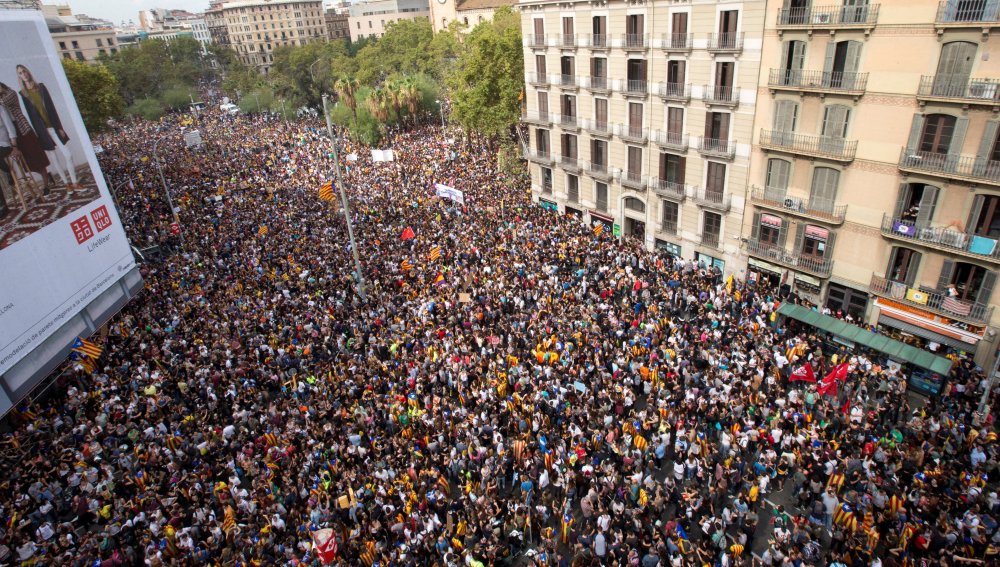One year ago, the Catalan independence referendum on 1 October became a turning point in the whole political situation in Catalonia and throughout the Spanish state. What we call the “Republican October” was characterised by an abrupt entry of the masses into the political arena. It saw an impressive mobilisation from below that challenged the apparatus of the state and the hesitation of the leaders of the Generalitat, becoming one of the most important challenges faced by the 1978 regime in 40 years. It could have gone much further. What was missing?
Why is it that, a year later, we find ourselves back at square one: with a pro-independence majority in a regional parliament? In fact, in many respects, we have taken steps back. Dozens of people who supported independence are now political prisoners and exiles, and many other activists have been indicted. There is a permanent threat that the Spanish state might intervene and suspend the devolved powers of Catalan institutions. The Catalan government accepts the limits set by the Spanish state. The republic, which a year ago was felt to be at our fingertips, now seems more distant. In order to continue the struggle, we need to make a sober balance sheet of what happened, of the strengths of a movement that acquired insurrectionary characteristics; but, above all, of its shortcomings, which have led us to this impasse.
We should begin on 6 September 2017, when the Catalan Parliament approved the call for a referendum. The parliamentary procedure was necessarily rushed in an attempt to sidestep the anticipated suspension of the referendum by the Spanish judiciary.
At that time, it was still unclear whether the referendum would actually take place. We explained that this depended on the relative correlation of forces based on three factors. Firstly, there was the Spanish regime of 1978, whose very foundations were threatened by any attempt at Catalan self-determination. Secondly, the petty-bourgeois nationalist politicians of Together for Yes (JxSí), as we warned, were incapable of using the revolutionary means necessary to carry out the referendum. The third variable was the level of mass mobilisation the call for a referendum could generate. This was the factor that surprised everyone. It overcame not only the vacillations of the Catalan government, but also the slogans of organisations such as the ANC (Catalan National Assembly). It was this factor that, in practice, was the driving force behind the independence referendum.
As expected, the Spanish state responded firmly and resolutely to the challenge presented by calling the referendum. The Constitutional Court immediately suspended the Catalan Parliament's decision and began to threaten all those involved: the Catalan government, the parliament's deputies who had voted for it, the local council mayors who had declared their readiness to organise it, municipal secretaries, volunteers and so on. All were considered accomplices in a crime against the state. At that time, the finances of the Generalitat were already under strict supervision by Madrid in a violation of regional powers.
The political repression, led by the State Attorney General, was accompanied by a frantic police operation to disrupt the logistics of the referendum: to find the ballot boxes, seize ballot papers, prevent the sending of census cards, etc. It was at this point that an increasingly strong wave of popular mobilisation in defence of democratic rights developed. Police searches of the offices of El Vallenc newspaper in Valls, and the printing company used by this newspaper in Tarragona on 9 September, provoked protest rallies.
Protesters shouted ironically "where are the ballots, the ballots where are they?" to the tune of a well-known Catalan song. This was accompanied by another slogan, showing a mood of resoluteness: "VOTAREM!" (We will vote!) And increasingly, "occupation forces, out!", which went from being a slogan limited to fringe groups to acquiring a mass echo. In an ascending spiral, the increase in repression of the state was met with the rise of popular mobilisation as a response.
Last year's Catalan National Day on 11 September was again a massive event with over a million people taking part in the main demonstration. Very significant was the demonstration and rally of the left-wing independence movement in the afternoon in Barcelona. There was a very militant atmosphere amidst the mostly young crowd, and many left-wing speeches delivered.
State repression took place, not only in Catalonia, but from the beginning was also aimed at preventing any acts of solidarity with the referendum in the rest of the Spanish state. Thus, in Madrid, the organisers of a rally in favour of Catalan self-determination had their venue cancelled. The rally was later held at a packed Teatro del Barrio, with hundreds of people following the event from outside. In Vitoria, in the Basque Country, a meeting that had already begun was broken up by the police and had to be continued outdoors. Clearly, there was potential to organise a campaign of solidarity and defence of democratic rights throughout the Spanish state. Unfortunately, neither the leaders of Podemos nor those of the United Left were up to the task. Hiding behind legalistic arguments about the so-called lack of "guarantees" from the referendum, they de facto put themselves on the side of reactionary Spanish nationalism.
The tension continued to increase in the following days, and especially after 14 September: the day on which the referendum campaign officially began. Repression continued – and escalated. Media outlets that had published referendum advertising were subject to threatening police searches. Official web pages for the referendum were closed down by the police. Referendum websites hosted on servers abroad were blocked in Spain. There was constant pressure on activists who fly-posted pro-referendum materials, with arrests, official identification by the police; and the confiscation of posters, buckets and glue.
This repression, which sometimes went even beyond what was technically legal, revealed the authentic character of the 1978 regime. It could in no way accept a questioning of one of its fundamental pillars: the unity of Spain, as guaranteed by the armed forces. It feared this would lead to a questioning of other pillars, such as amnesty for Franco's crimes; the existence of the monarchy that he installed; and the private property of the capitalists.
The "tumultuous crowd" of 20 September: a turning point
Finally, the accumulating tension overflowed on 20 September. Already, events on 19 September prepared the ground. In Terrassa, a police search, carried out without a court order, at a site of the private postal company Unipost, in violation of legally protected mail privacy, generated a wide response. Hundreds of people assembled at the doors of Unipost, preventing the departure of the Guardia Civil agents or the entry of the judge's representatives.
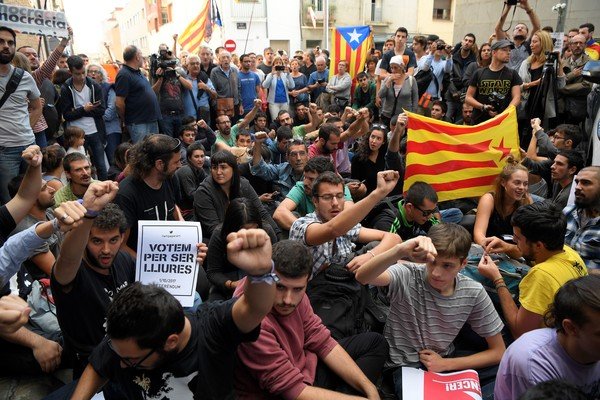 On 19 September, hundreds of people assembled at the doors of Unipost, preventing the departure of the Guardia Civil agents carrying out a search without a warrant / Image: fair use
On 19 September, hundreds of people assembled at the doors of Unipost, preventing the departure of the Guardia Civil agents carrying out a search without a warrant / Image: fair use
After more than five hours of siege, the Catalan police forces (the Mossos d'Esquadra) charged the crowds and allowed the Spanish Guardia Civil to leave the building.
Meanwhile, on the same day, in Reus, the masses’ patience ran out. For days, activists fly-posting for the referendum had been ID-ed by the local police. To this provocation was added the arrival of 50 police reinforcements, who had come to the city to participate in the operation against the referendum.
In the late afternoon, a group of activists were detained as they left the ANC offices to go fly-posting. This generated a call for mass fly-posting at 11pm in response.
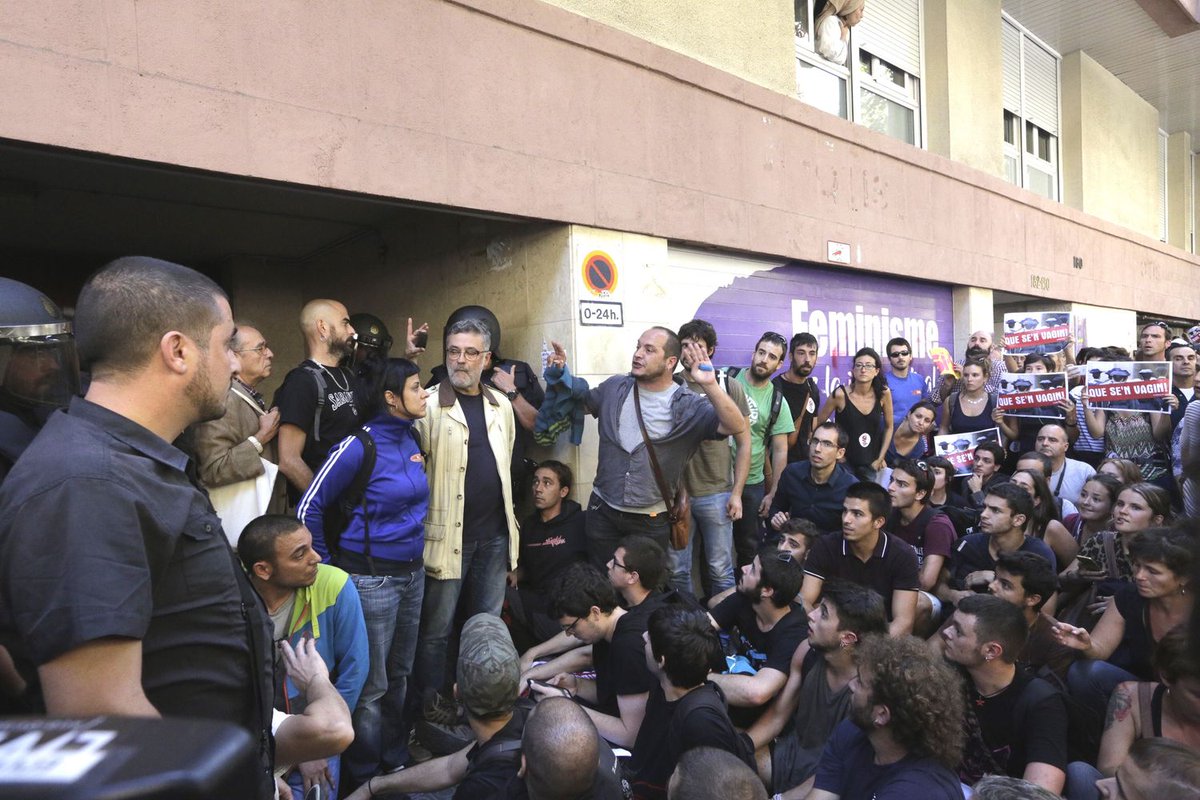 The defence of the CUP headquarters / Image: fair use
The defence of the CUP headquarters / Image: fair use
Thousands gathered in a spontaneous rally that marched through the town centre, ending in front of Hotel Gaudí, where the police reinforcements were staying. The crowd shouted, loud and clear, "Occupation forces out!" and "we will vote!"
Increasingly, wider sectors of the masses understood that the holding of the referendum depended on their direct participation in defiance of state repression.
On the 20th, we awoke to the news of “Operation Anubis.” In the early hours of the morning, the Guardia Civil had carried out searches and arrests at the private homes and official offices of senior officials of the Generalitat, who were assumed to be responsible for organising the referendum. Both the ANC and Òmnium called for rallies outside the headquarters of the Department of Economy on the corner of Gran Vía and Rambla de Catalunya. People start arriving, while the news of the arrest of 14 high-ranking Catalan government officers filtered out. The tension was growing.
At the same time, news came of an attempt by the police to search the CUP national headquarters on Casp Street, also without a court order, and there was an appeal to rally to defend it. From inside the building, all the posters and flyers were removed and distributed to the crowd that was defending the premises from the outside. In a few minutes, thousands of posters and items of propaganda passed from hand to hand, to be distributed throughout the country. The headquarters of Podemos in Catalonia are around the corner from the CUP's and its leaders, led by then-secretary, Albano Dante-Fachin, offered it as a base for logistical support.
It should be noted that Albano is the only leader of the non-independence left who can be proud of his conduct during the whole process, maintaining a strong position in defence of democratic rights, calling on people to participate in the referendum and taking part in the front line of all the mobilisations. This resulted in an internal coup in Podemos Catalonia, organised by the state leadership, which ended with his removal as leader.
The number of people gathered outside the Department of Economy kept growing. A line of Mossos protected the officers of the Guardia Civil who were guarding the door. The atmosphere was tense, but at the same time militant and festive. The police searches that day were regarded, correctly, as an intolerable violation of democratic rights and the beginning of the abolition of Catalan institutions. From the early morning, the slogan "general strike!” was added to the shouts of "we will vote!" By mid-morning, students at the universities declared themselves on strike and slowly converged to join the siege of the building. There were also rallies outside different official buildings in Via Laietana. At the premises of the CONC (Catalan CCOO trade union), located on the same street, full-time officials and workers came out to protest and blocked the street.
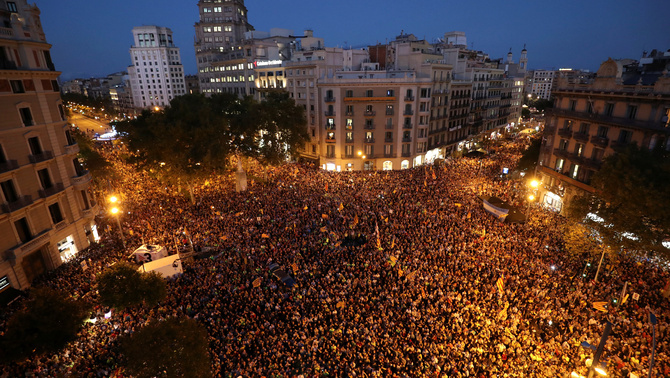 20 September marked a decisive turning point. The masses had entered the scene and had done their job in order to guarantee the holding of the referendum. Meanwhile, the leaders of the Catalan government hesitated / Image: fair use
20 September marked a decisive turning point. The masses had entered the scene and had done their job in order to guarantee the holding of the referendum. Meanwhile, the leaders of the Catalan government hesitated / Image: fair use
It is necessary to restore the historical truth of what happened that day. Jordi Cuixart and Jordi Sánchez, the leaders of Òmnium and the ANC respectively, are now in prison, charged with sedition for their participation in these events. Actually, the role of the ANC and the Omnium was at all times to try to calm the situation and steer it into safe channels. Volunteers of these two organisations with high-visibility vests tried to open a corridor to allow the departure of the judicial committee from the Department of Economy building. They were unable to do so. When both Jordis climbed on the jeep that the Civil Guard had left in front of the building, they asked the people to leave and go home, arguing that a demonstration of strength had already been made, but that it was necessary to put an end to the protest:
Yo no se lo que tú habrás visto, pero lo que pasó en realidad fue que ambos Jordis hicieron repetidos llamamientos a la no violencia y a que la gente se fuera a su casa, está grabado: pic.twitter.com/unhhDK6rkN
— Jorge Martin (@marxistJorge) September 13, 2018
At that time, there were about 40,000 people at the rally, filling the streets of the entire area. People did not leave. Some scolded the Jordis, firing back: "you go, we stay."
Movilización cada vez mayor en Conselleria d'Economia BCN fotos @naciodigital pic.twitter.com/4602UtldfX
— Jorge Martin (@marxistJorge) September 20, 2017
From the strictest point of view, it is true that there was a "tumultuous crowd" determined to prevent the "agents of the law" from exercising their functions, and this is the definition given in the current Spanish penal code (inherited from the Franco regime) of the crime of sedition. But the Jordis tried to prevent this, not promote it – and certainly not to take the lead in it!
The charges of sedition sum up the anti-democratic character of the ‘78 regime. In the first instance, because the crime of sedition under the current penal code is copied word for word from the Francoist criminal code of 1944, and was accepted without modification during the "transition to democracy." Furthermore, the court responsible for pursuing these charges, the National Court, is the direct heir of the Franco-era Public Order Tribunal. The judge that took the case, Ismael Moreno Chamarro, is a former Franco-era police officer.
The defence of the CUP headquarters was exemplary. Thousands of people prevented the entrance of the Guardia Civil and the Mossos without falling for their ample provocations. In a calm and firm way, the crowd finally forced them to leave empty-handed.
It was not until the early hours of the following morning that, finally, when there were very few people left, and after several charges by the Mossos, that the judicial committee carrying out the search was able to leave the Department of Economy.
20 September marked a decisive turning point. The masses had entered the scene and had done their job in order to guarantee the holding of the referendum. Meanwhile, the leaders of the Catalan government hesitated. Instead of unconditionally defending the parliament's decision of 6 September, the mayors of the PDeCAT and the ERC announced that they would submit to the legal summons.
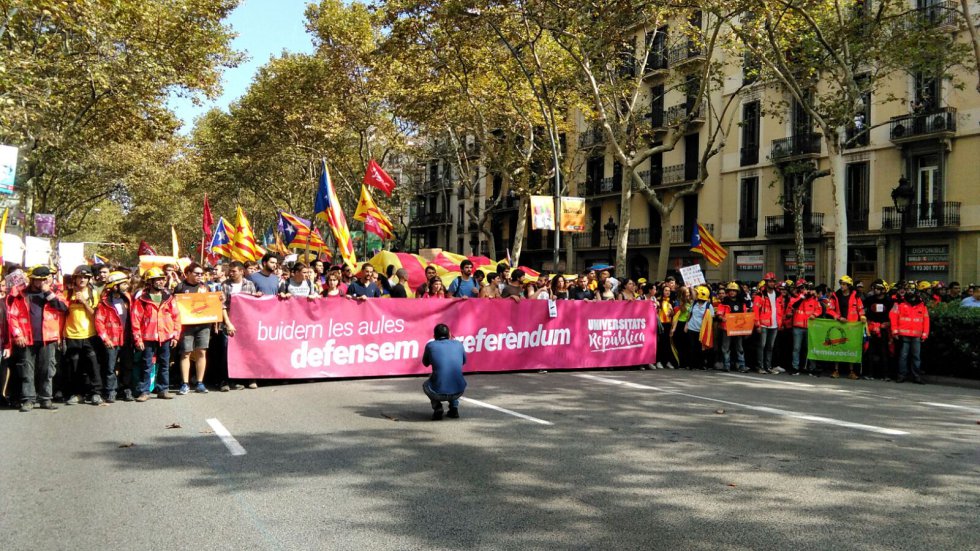 Firefighters stewarding the students' demo / Image: fair use
Firefighters stewarding the students' demo / Image: fair use
The Generalitat filed an appeal to the Constitutional Court, whose authority it was supposed to no longer recognise. Later, it was learned, by the leaking of police recordings, that within the Catalan government there was a silent struggle going on between ERC and PDeCAT. Both parties knew that they had not created the "state structures" that were supposed to guarantee the proclamation of the republic, and therefore they went to the referendum completely unprepared, but neither wanted to admit it for fear they would be accused of failure by the other. Instead of calling for a popular mobilisation against repression and to guarantee the referendum, there were calls for calm and tranquility; and appeals to the European Union.
20 September arrived. Ferry boats arrived at the Barcelona harbour, carrying the additional police officers who came to physically prevent the holding of the referendum. This caused another leap forward by the movement when the Barcelona dockers decided in a mass assembly not to handle these ships. These and the firefighters were the two most-organised sectors of the working class that played a decisive role in all mobilisations for democratic rights and against repression. The slogan of a general strike was gaining increasing support.
The participation of these sectors of the labour movement, far from being symbolic, had a very important practical nature. Firefighters, for example, organised the stewarding for many of the demonstrations and rallies in those days, to protect them from possible police action. And they did it by defying express orders not to participate in political actions, not to do so wearing uniform and so on. In a disciplined manner, they made themselves available to the movement to guarantee the defence of polling stations on 1 October.
At the same time, all the business organisations and the Catalan bourgeoisie firmly came out against the referendum and put themselves on the side of the Spanish state, organising a campaign of economic terrorism and threats against democratic rights, with the beginning of a corporate flight from Catalonia. With each passing day, the class character of this confrontation became clearer.
The CGT union took the initiative of raising a legal warning of a 24-hour general strike in Catalonia against repression. They set the date as 3 October: the first day that could be done within the legal deadlines. This was a very important step. In Spain, political strikes are not allowed and this was clearly a political strike. That the call was made by an anarcho-syndicalist trade union reflected the widespread support that the movement for the republic had gained as repression increased.
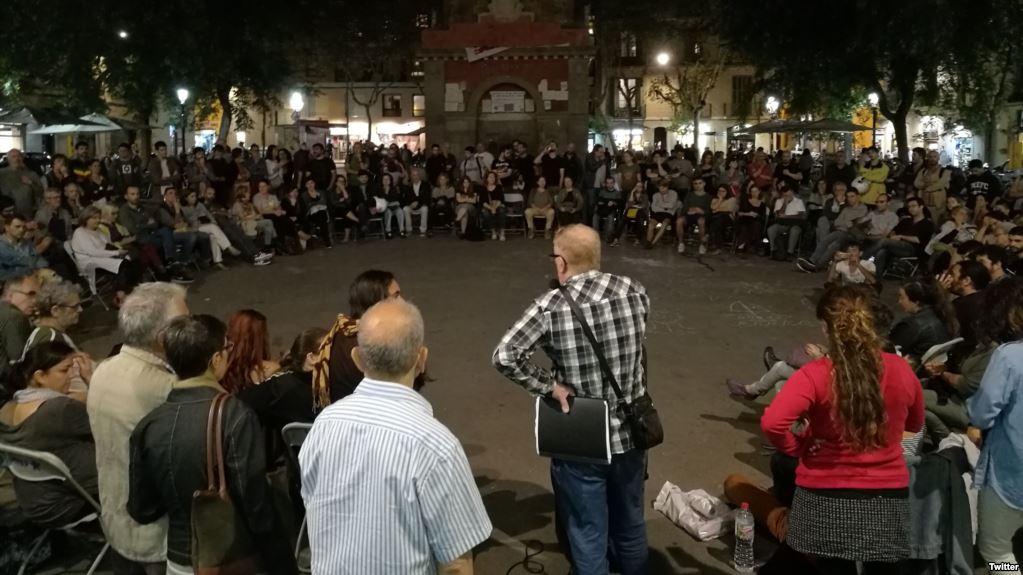 The idea that "only the people save the people" spread like wildfire throughout Catalonia, with CDRs springing up all over / Image: fair use
The idea that "only the people save the people" spread like wildfire throughout Catalonia, with CDRs springing up all over / Image: fair use
On 21 September, there were student strikes and mass meetings at universities and tens of thousands gathered outside the Catalan Supreme Court to demand the release of those detained following police searches the day before. The student movement, which was massive and of a very radical nature, continued almost uninterrupted until the day of the referendum, and led to the occupation of the historical building of the Rectorate, which became a space for discussion and organisation.
Also at this time, the Committees in Defense of the Referendum started to spread. The CDRs had begun to develop in an embryonic form in some localities in the spring, mainly at the initiative of the pro-independence left. Now this idea, that "only the people save the people," spread like wildfire throughout Catalonia, with CDRs and Neighborhood Defense Committees being set up in towns, cities and local communities. Moreover, in some cases (for example in Sabadell, population 210,000), CDRs acquired an almost military organisation and covered the entire city, convening mass assemblies in each neighbourhood and providing local coordination.
As in any revolutionary movement – and the movement for the Catalan Republic certainly had revolutionary features – the masses felt the need to equip themselves with broad and democratic organisations to coordinate and direct the struggle. This was the origin of the Soviets in the Russian Revolution of 1905. But similar bodies, with different names, have emerged in almost all revolutionary movements around the world and throughout history.
The masses were on the streets, ready to fight and to secure the referendum in defiance of the growing wave of state repression. And they did so going beyond the limits of the Catalan government and even the mass organisations of the sovereigntist movement.
Who guaranteed the referendum?
We see, for example, how the occupation of the polling stations was organised. The State Prosecutor's Office had issued precise instructions to the police (including the Mossos) that they had to be present, first thing in the morning, at buildings that could be used as polling stations in order to seal them off, and organise a 100m exclusion zone around them, issuing warnings of the serious criminal implications of violating it. Faced with this situation, the ANC circulated instructions on what to do on 1 October: the proposal was to respect the police perimeter and the exclusion zone and to form orderly queues that would remain throughout the day to "demonstrate the strong will of the Catalans to vote". That is: a symbolic action aimed at arousing public sympathy (and perhaps that of the European Union), but one without any practical consequences. If these instructions had been followed, there would have been no referendum.
Instead, the popular organisation from below issued a call to occupy schools and colleges that were to be used as polling stations from Friday evening, to ensure that they would be open on Sunday for the referendum. Spontaneously, and in a self-organised manner, the CDRs and other ad-hoc organisations undertook the task of physically guaranteeing the referendum took place, confronting the threats of the state.
What happened on 1 October is already known. The brutal repression by the police and the Guardia Civil – which left more than a thousand injured and provided images of violence we will never forget – could not break the will of the hundreds of thousands of people who organised themselves to ensure the referendum took place, nor the 2.2m who went out to vote, overcoming all obstacles. At 6am, it is estimated that more than 200,000 people were already in polling stations, defending them against possible police action. At 9am, it was estimated that there were half-a-million. In some cases (including in Sant Carles de la Ràpita, Mont Roig del Camp and Sabadell), the organised might of the people forced to police to retreat. In fact, the scenes of repression – with the ‘forces of law and order’ cracking the skulls of citizens who merely wanted to exercise a democratic right, and balaclava-clad civil guards seizing ballot boxes by force – only resulted in even more people coming out to vote.
Without a doubt, this was the most important challenge the 1978 regime had endured in 40 years. It was determined to prevent the referendum from taking place, but in spite of everything the referendum went ahead. The organised people had broken the principle of authority of the state. The revolutionary implications of this fact cannot be underestimated.
Even on the day of the referendum, there were vacillations in the Catalan government. During midday discussions, they proposed suspending the referendum in the face of police violence. In fact, the leaders of JxSí never thought that the referendum could be carried out against the opposition of the state. What they wanted (as later confirmed by Catalan minister Clara Ponsatí's statements to the effect that they were "bluffing") was to defy the state as far as possible, but without any serious resistance nor calling for mobilisation that went beyond symbolic demonstrations, so that afterwards they would be able to say "we have tried but we were not allowed" and use the conflict to force negotiations (perhaps with EU mediation).
Clearly, it was the action of the masses that undermined this ‘strategy’. This is a significant fact that explains what happened on the days that followed. The problem faced by the government and the leaders of JxSí was that they themselves had voted for a law that said the results of the referendum were binding and that the republic should be declared within 48 hours in the event of a YES vote. They never believed that the referendum would be held, and now they faced an unsolvable dilemma. And here we saw what stuff the leaders of the nationalist petty bourgeoisie are made of. Unable to conceive of a struggle with the state based on the mobilisation of the masses, they hesitated for four weeks, trying not to make any decisions, until they finally made one that had a merely symbolic value.
The first example of JxSí's perplexity was that they delayed the parliament's session until 10 October, when it was legally supposed to be held within 48 hours of the referendum. They wanted to have room to negotiate and also wanted the session to take place as late as possible to avoid direct pressure from the masses, which they thought would ease as the days passed.
The 3 October general strike
The repression of 1 October encouraged the general strike, already convened for 3 October. The call for a strike affected not only those in favour of Catalan independence but acquired a broader, anti-repressive and democratic character. The leaders of the main trade unions, CCOO and UGT, and all the official organisations and the Catalan government could not be seen as opposing the strike head on and therefore initiated a manoeuvre to try to water down its content.
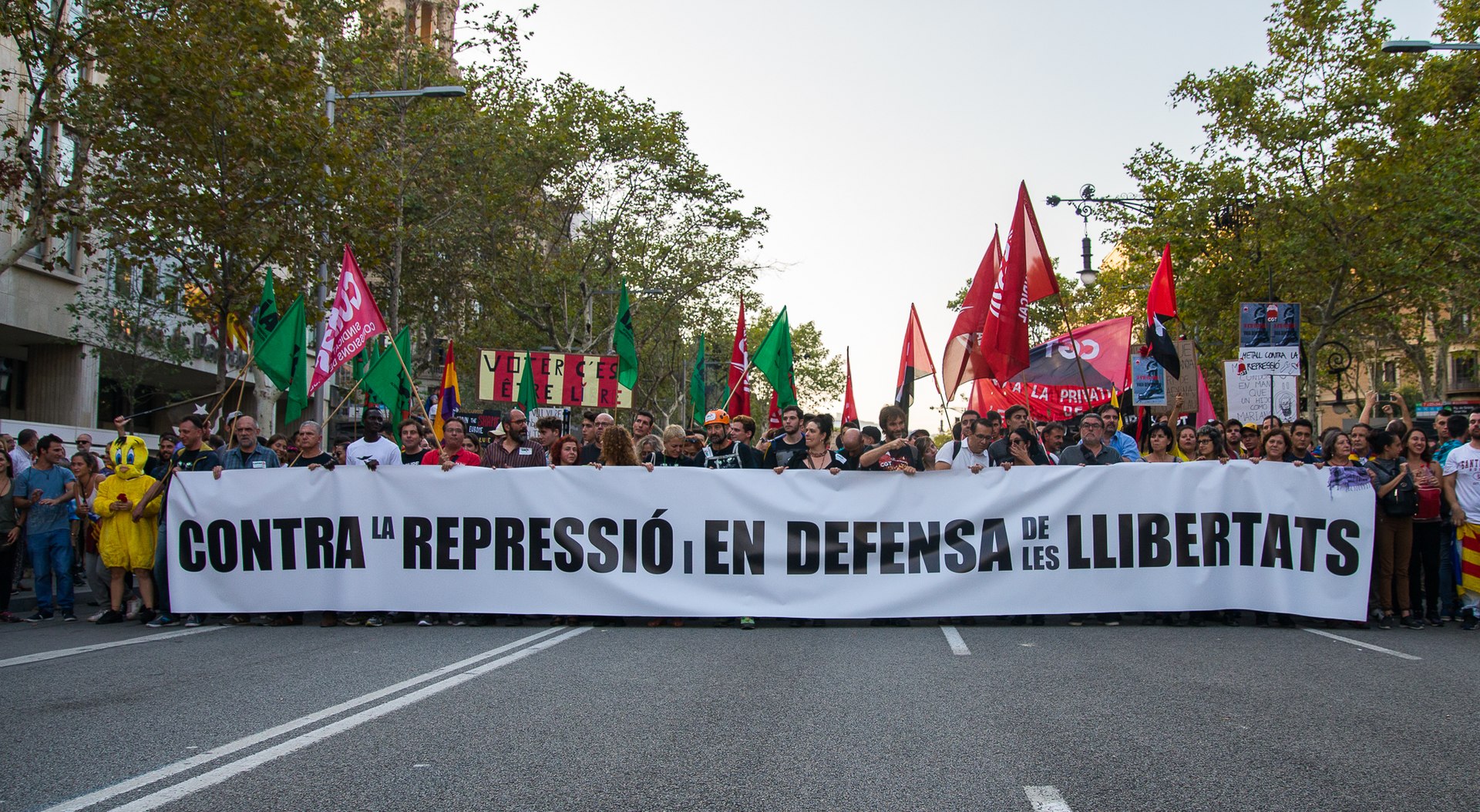 An insightful bourgeois commentator commented: "Puigdemont has lost control of Catalonia, it is revolution" – and was not very far off / Image: fair use
An insightful bourgeois commentator commented: "Puigdemont has lost control of Catalonia, it is revolution" – and was not very far off / Image: fair use
Thus, a "countrywide stoppage" was declared, in which employers and workers were supposed to mutually agree on work stoppages (as opposed to strikes). In addition, a "unity" demonstration was convened with the intention of pre-empting the call of those organisations that had called the strike. In practice, in many workplaces, the bureaucracy of CCOO and UGT acted as strikebreakers. At the SEAT car plant, they handed out flyers clarifying that they were not calling for a strike!
All these attempts were futile, given the enormous force of the movement on 3 October. The strike was observed by a majority of workers in the public sector, healthcare and education and to a more limited extent in industry and transport. The demonstrations and pickets were so massive that they brought cities and towns to a standstill throughout the day. In Barcelona, an impressive crowd filled the streets, overflowing the different demonstrations that had been called, both official and otherwise. There was a strong feeling of rage against the police, with massive columns of demonstrators marching towards the hotels where the police reinforcements that had come to prevent the referendum were staying. The atmosphere was clearly insurrectional. An insightful bourgeois commentator commented: "Puigdemont has lost control of Catalonia, it is revolution" – and was not very far off.
An indication of how advanced the situation was – and how concerned the Spanish ruling class had become – was the King's televised speech that evening. Normally, the monarchy pretends to be above party politics: a neutral institution representing "all Spaniards". It is a trick to cultivate the institution’s legitimacy so that it can be used more effectively in times of serious national crisis. This was clearly the case after 1 October. The King came out with a tough message, without making any formal concessions of any kind. The purpose of that speech was to unify all the forces of the regime against the Catalan Republican movement and at the same time show the petty-bourgeois Catalan politicians that there would be no concessions, so they should retreat. It was, however, a strategy that had a major drawback: any authority that the monarchy still had in Catalonia was totally destroyed.
In the days between 1 October up to the parliamentary session on 10 October, there was an unprecedented mobilisation of the Catalan bourgeoisie and its political representatives to put pressure on Puigdemont not to declare the republic. There were public statements by all the employers’ organisations – as well as CiU and PDeCAT politicians Artur Mas, Duran, Lleida, Santi Vila and Marta Pascal – all warning against a unilateral declaration of independence. Puigdemont had two options: capitulate and be rejected by the movement, or to go ahead and be rejected by the bourgeoisie. Finally, he did not choose either of them and tried to delay the outcome.
The people decide – the government vacillates
Thus, the plenary of the Catalan Parliament on 10 October made a general and ambiguous statement about the mandate of the referendum, using deliberately unclear language in a misguided attempt to avoid judicial action. And even this statement, which said nothing specific, was declared to be "suspended" pending a call to the Spanish government for dialogue and negotiation.
In addition, the session took place behind closed doors, with the surrounding Parc de la Ciutadella closed to the public, further removing the deliberating MPs from the people who had voted them in and fought for the referendum. The nationalist petty bourgeoisie had been threatened directly by the state and did not want any more "tumultuous" incidents or any possibility of a direct reaction by the masses when it was announced that the declaration of the republic was suspended.
The response from the state was predictable: an ultimatum was issued on the following day, 11 October, to clarify the situation, under the threat of the suspension of Catalan self-rule through article 155 of the Spanish constitution. The deadline was 16 October. Then-Prime Minister Rajoy could count on the unconditional support of the PSOE and its leaders, especially following the intervention of the King.
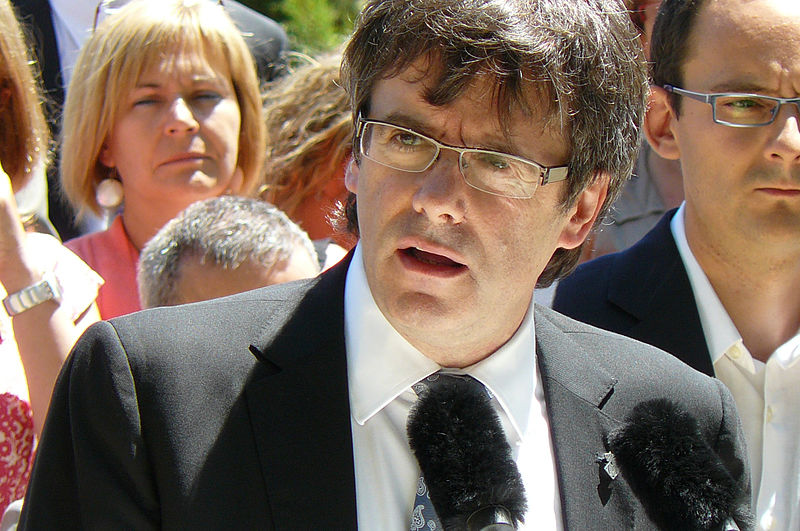 The petty-bourgeois nationalist leadership of the republican movement vacillated and backslid, while the ‘78 regime acted in a united and firm way / Image: Puigdemont acompanyat de càrrecs electes de CiU
The petty-bourgeois nationalist leadership of the republican movement vacillated and backslid, while the ‘78 regime acted in a united and firm way / Image: Puigdemont acompanyat de càrrecs electes de CiU
Puigdemont’s manoeuvre was also an attempt to force the intervention of the European Union to push the Spanish state to sit down in negotiation talks. Clearly, this was a delusion. The European Union is a capitalist body that is only interested in stability in order to do business, and the break-up of an important and economically fragile state within its bounds would not create a business-friendly environment. Throughout the whole process, the EU unwaveringly defended "the rule of law", which, in the case of Spain, includes its indivisible unity, as guaranteed by the armed forces.
When 16 October arrived, the deadline of Rajoy's ultimatum, Puigdemont responded with a new dilatory tactic and by asking once again for negotiations. The strategy of Puigdemont and the leaders of JxSí was totally counterproductive from the point of view of the mass movement. Instead of firmness, they showed indecision. Instead of clarity, they created confusion.
For its part, the ‘78 regime acted in a united and firm way, without backsliding or hesitation. The same day, on 16 October, the judge ruled for pre-trial detention without bail for Jordi Cuixart and Jordi Sánchez. This was a totally disproportionate decision but one that sent a clear message to the leaders of JxSí: this is what will happen to you if you take a single step further.
On the same day, there were mass protests and half a million marched in Barcelona on Saturday the 21st, demanding the freedom of the Jordis, but also asking for the proclamation of the republic.
Meanwhile, the CDRs, now Committees for the Defence of the Republic, had for the first time called a national coordination meeting of 200 representatives in Sabadell and began to advance their own slogans and demands. The CUP was also critical of the government's hesitation. It must be said, however, that when it came to the moment of truth, it seemed that the CUP saw its own role as putting pressure on Puigdemont to give ground, rather than organising an alternative leadership for the movement. Such a leadership, based on strengthening the CDRs, would have been able to advance the cause of national self-determination. Instead, the CUP accepted, albeit with protest, the suspension of the declaration on the 10th.
Puigdemont’s vacillations reached a peak on the night of October 25th and the morning of the 26th. Under enormous pressure from the Catalan bourgeoisie and its most direct representatives within the PDeCAT, and facing the threat by the Spanish regime to apply article 155 (which had already been announced on the 21st) and crush devolved Catalan institutions, the Basque Nationalist Party offered a way to reach an agreement that Puigdemont was willing to accept. The agreement was that Puigdemont would call for early Catalan elections instead of declaring independence. In return, the Spanish state would not apply article 155 and perhaps release the two Jordis (on bail). Puigdemont announced a press conference at noon. The stock market reacted with a rise.
Finally, however, the agreement was not possible. The pressure within the ranks of JxSí (with two deputies resigning and the belligerent declarations of ERC leader Rufián); the opposite pressure from Spain (where the PP was in turn under pressure from the Cs); but above all the angry mood of the mass demonstration of students, who marched through the streets of Barcelona that same morning and headed to Plaça Sant Jaume; eventually blew up the agreement.
Finally, on Friday the 27th, parliament voted for the declaration of the republic and almost simultaneously the Spanish Senate authorised the government to apply article 155 and suspend Catalan self-rule. On the morning of Saturday the 28th, the terms of the Spanish intervention were announced: a true coup d'état against democracy, applied with the unconditional support of the PSOE.
The declaration of the Catalan Republic, however, was intended to be a purely symbolic act without any intention of carrying it into practice. The Catalan government met that same evening but did not make any decisions. The Spanish flag continued to fly at the Palau de la Generalitat, the Catalan government disappeared during the whole weekend and the order to remove the chain of command in the Mossos was abided by. On Monday morning, it was clear that the Catalan government had proclaimed the republic but without any plan to defend it. The president and some ministers were in exile, others would soon be evicted from their offices, summoned to the courts and put in pre-trial detention without bail. And all this without any kind of resistance, nor any call to defend the republic that had just been proclaimed.
Could the proclaimed republic have been defended?
It has been argued that defending the republic would have led to a bloodbath that had to be avoided at all costs. This argument is false for many reasons. To begin with, this is an argument in favour of not doing anything at all. The constitution of 1978, one of the constituent pillars of the regime, clearly states that the unity of Spain is guaranteed by the armed forces. Therefore, any serious challenge to the regime will face the possibility of confrontation with the army. This is not an empty threat. It was later learned that the state had detailed plans to enter parliament (by air and through the sewers with special operations units) in case a republican government barricaded itself in. But that is something that was already known. Anyone who is serious about defying the foundations of the 1978 regime must know, before beginning, that this possibility exists.
The conclusion that the petty-bourgeois leaders of JxSí drew from this is that it was impossible to defend the republic. They expected, in vain, that in the face of the threat of state violence (and its use on 1 October), the European Union would intervene. Insofar as it did not, they thought everything was lost.
But this is not the only possible conclusion. Far from it. There is another: in order to exercise the right of self-determination, revolutionary means must be used. What do we mean by this? First of all, trust must be placed in the organisation of the masses and in their capacity to make decisions, and this must be strengthened. Only if the revolutionary masses feel that they control the movement, that they have leaders of their own whom they can trust, will they have the boldness to go to the end. This means strengthening the CDRs, spreading them throughout the country, and providing them with a democratic structure of elected delegates to coordinate them at the national level. That is, to turn them into soviets: organisations of workers’ representation and power. Decisions should not be made at the Generalitat Palace, behind closed doors, under the pressure and blackmail of the bourgeoisie and with the ‘advice’ of a former president that we had already sent to the dustbin of history (Artur Mas). They should be made democratically by the movement itself after an open debate over different proposals.
Secondly, measures must be taken that will make the republic a practical objective – one that is worth fighting for. The slogan of the CUP in this sense is totally appropriate: "Bread, housing, jobs – republic." With a clear strategy, those sections of the population that are still reluctant, because they are rightly suspicious of the former leaders of CiU and their policies of cuts and corruption, can be won over to the struggle for a republic. In other words, the struggle for the republic must acquire a social character, as well as a democratic and national one. These two measures would strengthen our side.
Third, the strength of the opponent must be undermined by all possible means. This can be achieved by calling on the working class and all the peoples of Spain to rise up with Catalonia to overthrow the regime of 1978 that oppresses and subdues us all. This means linking the struggle for the Catalan Republic with the struggle against the monarchy that Franco created, the fight against impunity for the crimes of the Franco regime, against the "Gag Law", the labor counter-reform and so on. Such an appeal would have a very powerful impact and hinder the use of repression by the state. What's more, a clear strategy in this regard would help us win to the struggle for the republic those sectors of the working class in Catalonia who feel bound by familial and cultural ties to Spain. That is to say, the fight for the republic must be given an internationalist character.
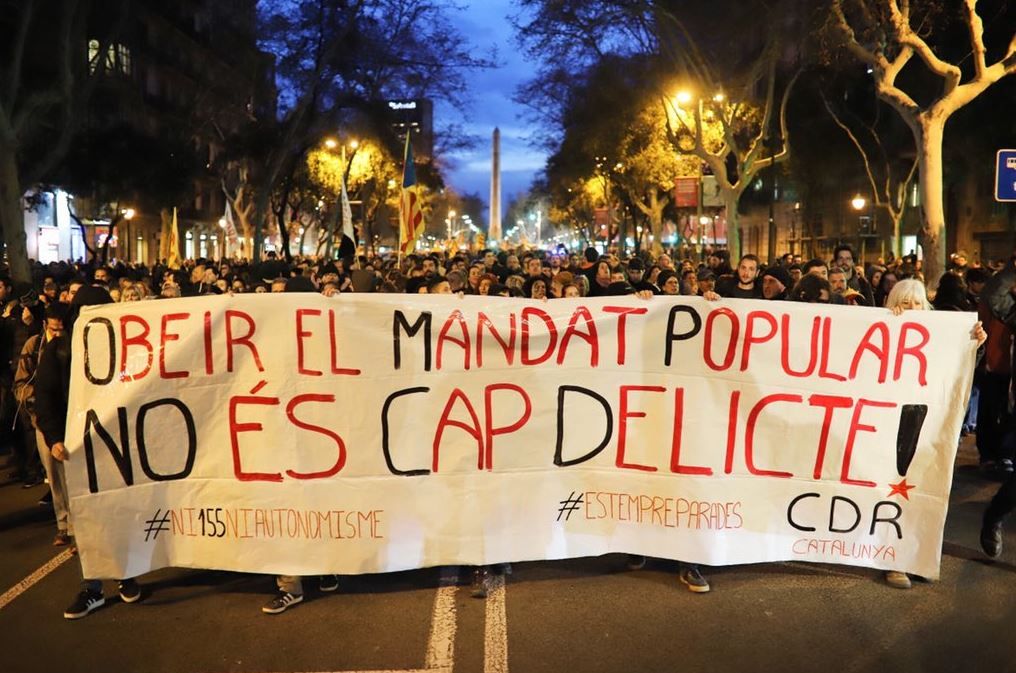 The movement for the republic must give itself a leadership worthy of the accomplishments and sacrifice of the people; one willing to use the revolutionary means necessary to achieve victory / Image: CUP Sant Martí
The movement for the republic must give itself a leadership worthy of the accomplishments and sacrifice of the people; one willing to use the revolutionary means necessary to achieve victory / Image: CUP Sant Martí
One could say: “yes, but, despite everything, they have the army and would not hesitate to use it.” Wrong. The reactionary ‘78 regime would not hesitate to use the army, and in the army there is no lack of pro-Franco officers willing to offer their services. However, their intentions are one thing, what they are capable of doing is quite another. In all revolutionary situations in history, there comes a time when the apparatus of the state breaks down. We are now celebrating 50 years since May ‘68 in France, when a general strike of 10m workers engaged in factory occupations paralyzed the country. At that time also, De Gaulle and the French ruling class thought of using the army. Finally, they did not do it for fear that, in the first confrontation, the army would have split and the soldiers would have fraternised with the strikers. Faced with a revolutionary general strike with road blockades, even the state apparatus is paralyzed. An indication of what is possible was evident when the Barcelona dockers refused to handle the ferries carrying police into Catalonia.
These are the prerequisites for the defence of the republic: to give the struggle a democratic and mass character, to give it a social and internationalist character, and to use revolutionary methods of struggle (general strike, the occupation of factories, road blockades, self-defense committees and so on). These were never contemplated by the petty-bourgeois leaders of JxSi at the helm of the movement. This is not a criticism of the personal courage and sacrifices made by some of them, who are now in jail or in exile. The problem concerns their political and strategic shortcomings.
On 27 October, after proclaiming the republic, what should have been done? First of all, the Catalan Republican government should have urgently passed the "decrees of dignity" (all the parliament's decrees blocked by the Constitutional Court) and also decrees to repeal the Gag Law, the Labor Counter-Reform, to ban house evictions, to abolish tuition fees, and a whole set of social and democratic measures that would send a clear message of what kind of republic had been proclaimed and stood to be defended.
Secondly, a call should have gone out to the people to remain mobilised in the streets and in defence of official buildings. This should have been accompanied with an appeal to cover the territory with a tight network of CDRs, in each town and city, in every neighbourhood every factory. These committees should have called a National Revolutionary Constituent Assembly of elected delegates to choose a provisional republican government. These CDR should have been made responsible for the organisation of common affairs of the local public administration of neighbourhood areas (providing supplies, public order, etc.) And a fraternal appeal should have gone out to the working class and peoples of the Spanish state to follow the example of the Catalan Republic.
In short: the tools that had guaranteed the referendum, paralysed the country on 3 October, and successfully defended the CUP headquarters on September 20, should have been used.
All of this would not have guaranteed victory in itself, but would have created much more favourable conditions in which to defend the newly-declared republic.
Before discussing how to move forward, and in which direction, we must discuss in a calm and sober way the lessons of the Republican October. Those who do not learn from history are doomed to repeat their mistakes. And all these lessons are concentrated in one crucial, central point: the movement for the republic must give itself a leadership worthy of the accomplishments and sacrifice of the people; one willing to use the revolutionary means necessary to achieve victory.

